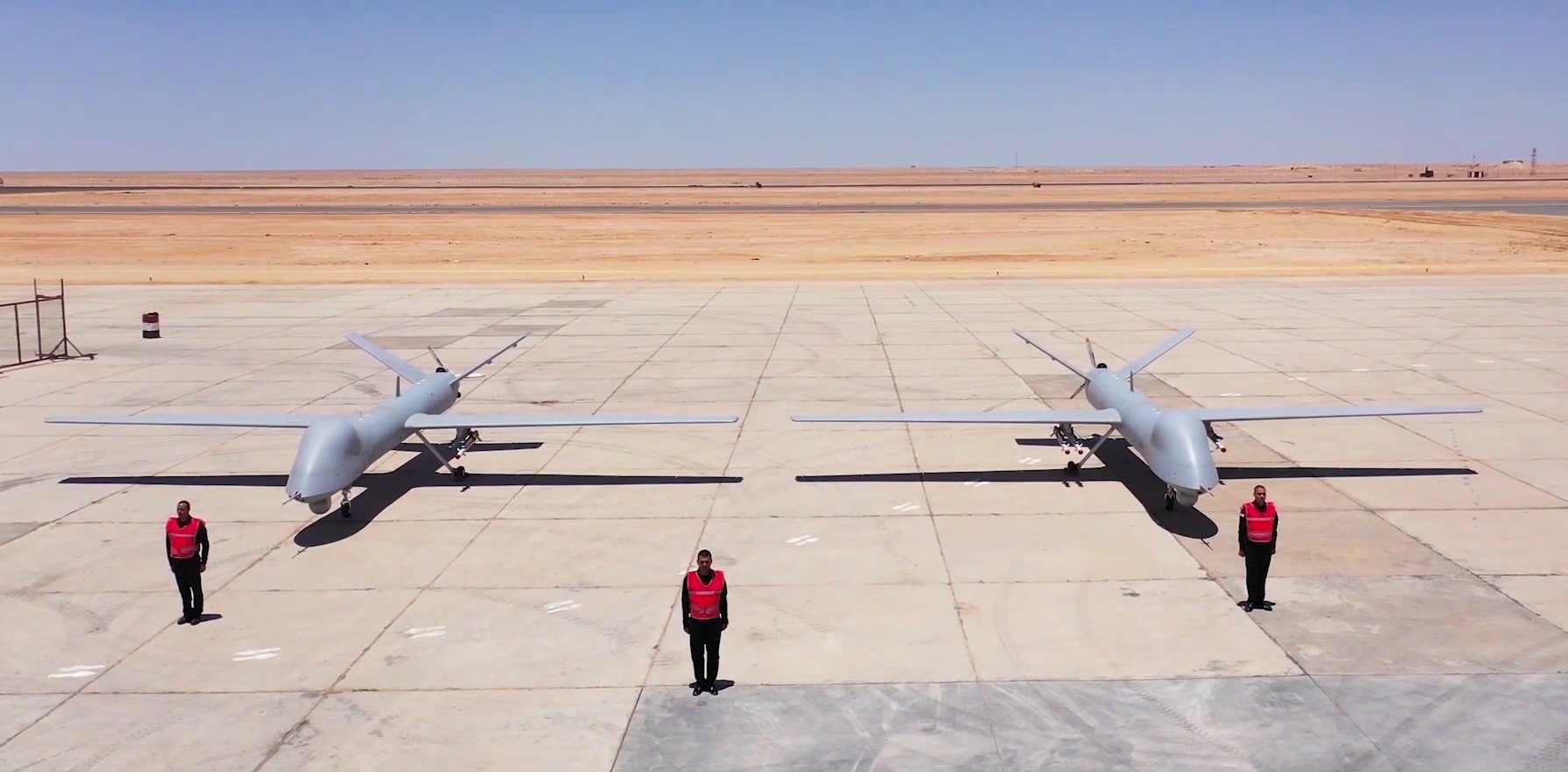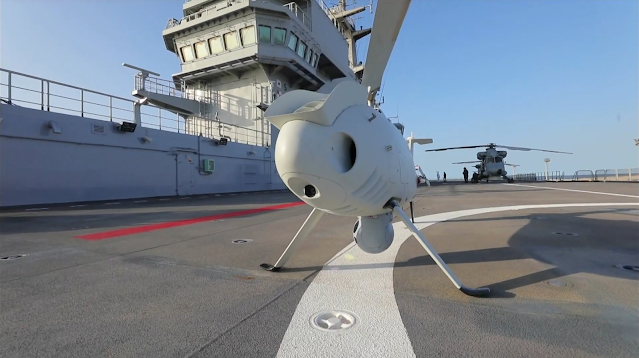By Stijn Mitzer and Joost Oliemans
Egypt has a long tradition of acquiring military equipment from a multitude of sources rather than solely relying on one country in case it's suddenly to be sanctioned, potentially cutting off its military from spare parts and munitions. The Egyptian Air Force currently operates jet aircraft sourced from Russia, France, Czechia, the U.S. and China, and the situation is little different within the other branches of the Egyptian Armed Forces. Although greatly complicating the inventory of spare parts and weaponry, this situation ensures that Egypt is never without a source of armament.
The country's attempt at diversifying its sources of armament and equipment is carried over in its inventory of unmanned aerial vehicles (UAVs). Currently operating a number of UAV and unmanned combat aerial vehicles (UCAV) types, the speed with which Egypt's UAV arsenal has developed has been relatively slow compared to other Arab nations like Saudi Arabia and the UAE. However, Egypt is well on its way to further advance its unmanned capabilities, not only acquiring new UAV types but also securing the licenses to produce these designs in Egypt.
In the late 1980s, the Republic of Egypt was one of the first Arab nations to field reconnaissance UAVs. The effective use of UAVs by Israel during the 1982 Lebanon War is sure not to have gone unnoticed in Cairo, possibly spurring Egyptian efforts to acquire a similar capability. Indeed, around the same time, the U.S. Teledyne Ryan company in cooperation with Scaled, initiated the development of a drone specifically tailored to Egyptian requirements. [1] Officially designated as the TR 324 but more popularly known as the Scarab, what Egypt ended up acquiring was a highly advanced stealthy jet-powered reconnaissance drone capable of taking photographs along a pre-planned route.
The TR 324 is launched by means of a RATO booster and is recovered by a parachute after completing its mission.
The Egyptian Air Force (EAF) took delivery of a total of 59 TR 324s, but only ever assembled nine of them. [1] It appears plausible that the other fifty examples were to be held back for war-time use, with the nine uncrated examples sufficient for training and peacetime operations. These reportedly flew 65 missions from their home base at Kom Awshim, south of Cairo. [1] It is unknown whether the EAF still maintains the TR 324 as an operational asset as of 2021.
 |
A TR 324 'Scarab' with its rocket booster still attached. |
Perhaps then it's all the more surprising that there was little further development of Egypt's UAV arsenal throughout the 1990s and 2000s. Whether this was due to a change in priority within the Egyptian military, a cautious approach towards UAV developments or a refusal by the U.S. to provide it with more advanced drones is unknown, although a combination of the latter two theories ceratinly appears likely. Whatever the cause, the result was the same, with Egypt slowly losing much of the strives it had previously made. It can be argued that Egypt only managed to keep its lead over other Arab nations because these made no serious attempt to establish a UAV capability during this period.
 |
An Egyptian R4E-50 SkyEye flies next to the Giza pyramids near Cairo. |
Renewed efforts to launch UAV operations in Egypt only began in earnest in the early 2010s, when the country acquired the ASN-209 reconnaissance UAV from China and later commenced license-production of the type as well. [4] In 2011, Egypt also disclosed its interest in the Turkish Anka UCAV by Turkish Aerospace Industry. [5] A souring in relations between Egypt and Turkey would ultimately prevent an acquisition of the system however, and the Egyptian Air Force had to wait a little while longer before it could introduce an armed drone type into service.
This finally occured in 2016, when the Egyptian Air Force received its first Wing Loong I UCAVs from China. The actual number of Wing Loong Is received by Egypt remains somewhat of a mystery, with the oft-repeated claims of more than 75 Wing Loong Is being operational with the EAF likely a significant overestimation. [6] Egypt almost immediately deployed its Wing Loong Is to the Sinai Peninsula to participate in operations against Islamic State, and to air bases along its western border with Libya to conduct anti-smuggling operations. [7] Known deployment locations include Bir Gifgafa in the Sinai and Dakhla Oasis Airport and Uthman air base in central and and western Egypt.
In Egyptian service the Wing Loong Is have so far been seen armed with AKD-10 (Blue Arrow 7) and TL-2s air-to-ground missiles (AGMs). The use of TL-2 AGMs doubles the amount of armament
that can be deployed by each Wing Loong I, which otherwise can carry just two munitions under its two hardpoints each. In the years following their acquisition, follow-up orders for large numbers of improved Wing Loong IDs (which are fitted with four hardpoints), Wing Loong IIs and CH-5s has frequently been reported. However, neither of these types has so far been sighted in Egypt, and these reports should be treated with caution until any evidence becomes available. [6]
 |
Egyptian Wing Loong I UCAVs armed with TL-2 AGMs. The use of double racks for the TL-2s enables the Wing Loong I to carry up to four munitions instead of the usual two. |
The 2020s began with a flurry of news that Egypt would soon acquire licenses to produce foreign UAV designs and set up production lines for them in Egypt. [10] [11] This is so far said to have included designs from Belarus, Italy and the UAE. [10] [11] [12] Although the Belarusian type(s) Egypt has expressed interest in are as of yet unknown, the Italian Falco Xplorer MALE UAV designed by the Leonardo company is one system Egypt has reportedly voiced its interest in. [11] In 2021 it was also revealed that Egypt had started local production of the Emirati-designed Adcom Yabhon Flash 20, locally known as the 'EJune-30 SW' (After the June 30 revolution in 2013). [12] The indigenous production of the Flash 20 would mirror Algeria's attempts at setting up an indigenous production line for Emirati combat drones. [13]
The future of unmanned aerial operations in Egypt seems bright. Set to introduce a number of new UAV and UCAV types into service as well as securing the license to produce these in the country, Egypt could soon attempt to win back the leading position it had during the late 1980s and 1990s. Its indigenous industry could take a role in this as well, with newly-unveiled designs like the Thebes-30 showing the country also attempts to involve its own national talent. The Egyptian military has surely paid attention to the 2020 Nagorno-Karabakh War, and might attempt to invest in types such as loitering munitions as well. However, before Egypt attempts to introduce entirely new capabilities, it could first attempt to address the general lack of tactical UAVs in the ground forces, ensuring that every branch is to reap the benefits of UAVs.
Surveillance Unmanned Aerial Vehicles
 RQ-20B Puma AE II [2019]
RQ-20B Puma AE II [2019]  R4E-50 SkyEye [1989] (Likely to have been decommissioned)
R4E-50 SkyEye [1989] (Likely to have been decommissioned) TR 324 'Scarab' [1988] (Likely to have been decommissioned)
TR 324 'Scarab' [1988] (Likely to have been decommissioned)  ASN-209 (Licensed for domestic production by the Arab Organization for Industrialization)
ASN-209 (Licensed for domestic production by the Arab Organization for Industrialization) Al-Saber [2020]
Al-Saber [2020]
Unmanned Combat Aerial Vehicles
 CAIG Wing Loong I
[2016] Can be armed with a variety of up to two PGMs)
CAIG Wing Loong I
[2016] Can be armed with a variety of up to two PGMs)  Adcom Yabhon Flash 20 ''EJune-30 SW'' [2021] (Armed with up to eight Nimrod AGMs or sixteen 120mm mortar rounds)
Adcom Yabhon Flash 20 ''EJune-30 SW'' [2021] (Armed with up to eight Nimrod AGMs or sixteen 120mm mortar rounds)
Target drones
Indigenous UAVs
 Nut ''Not'' [2021] (Has yet to enter service)
Nut ''Not'' [2021] (Has yet to enter service) Thebes-30 [2021] (Has yet to enter service)
Thebes-30 [2021] (Has yet to enter service) Unknown Target Drone [2018]
Unknown Target Drone [2018] Unknown VTOL UAV [2018] (Has yet to enter service)
Unknown VTOL UAV [2018] (Has yet to enter service)
[2] "Egypt Begins Using Unmanned Aircraft for Reconnaissance" Aviation Week and Space Technology, 23 January 1989.
[4] Egypt starts the production of Chinese Unmanned Aerial Vehicle ASN-209 https://www.armyrecognition.com/june_2012_new_army_military_defence_industry_uk/egypt_starts_the_production_of_chinese_unmanned_aerial_vehicle_asn-209_egyptian_armed_forces_0706122.html
[5] Turkey, Egypt Discuss Possible Export of Anka UAV https://defense-update.com/20110923_turkey-egypt-discuss-possible-export-of-anka-uav.html
[6] 翼龙翱翔东北非!埃及两次共引进108架,可挂载8枚空地导弹 https://m.sohu.com/a/382780569_120126853/?pvid=000115_3w_a
[10] Belarus to produce UAVs in Egypt https://www.defenceweb.co.za/aerospace/unmanned-aerial-vehicles/belarus-to-produce-uavs-in-egypt/
[11] Egypt seeks more advanced UAV capabilities https://www.shephardmedia.com/news/uv-online/premium-egypt-seeks-more-advanced-uav-capabilities/
[12] Egypt unveils locally made drones at EDEX 2021 https://www.defensenews.com/industry/techwatch/2021/11/30/egypt-unveils-locally-made-drones-at-edex-2021/
[13] Algiers Calling: Assessing Algeria’s Drone Fleet https://www.oryxspioenkop.com/2021/12/algiers-calling-assessing-algerias.html

.png)







